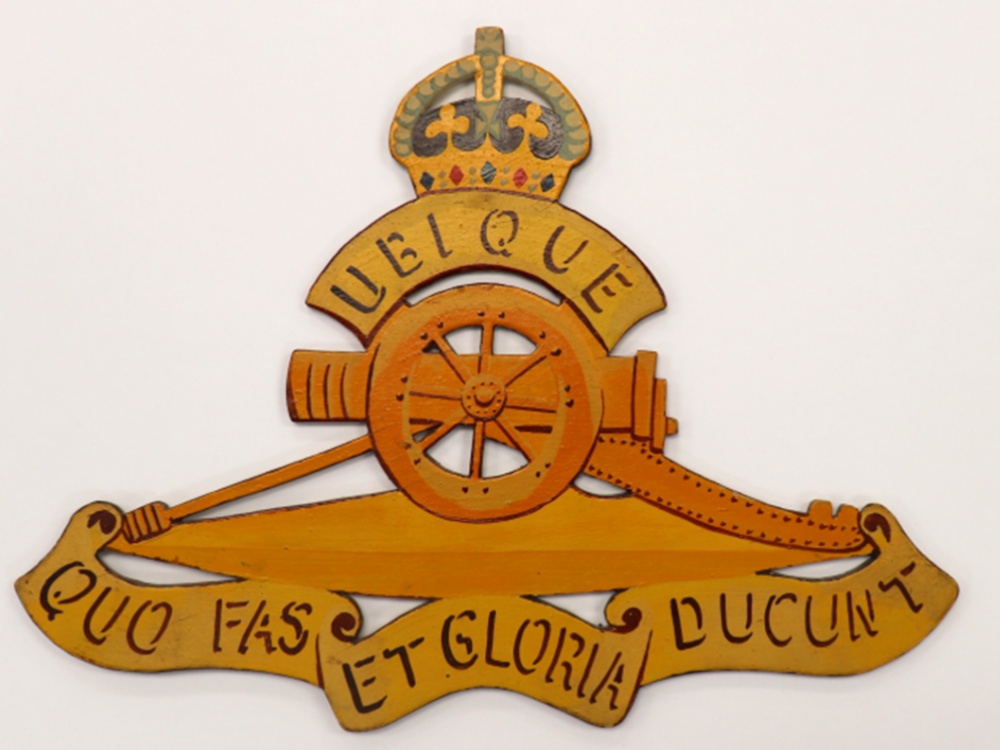
Front side of the crest designed by a First Nations soldier and on display at the RCA Museum at CFB Shilo. (Photo: submitted to Shilo Stag)
Shilo Stag Media
Indigenous Veterans Day, November 8, is being honoured at the RCA Museum with the display of the handcrafted RCA Crest—a poignant reminder of the struggles faced by Indigenous soldiers like Gunner Paul Gladu.
Gladu and many other Indigenous soldiers who fought in WW2 did not receive the same benefits as other Canadians after the war.
“The crest is a powerful symbol of their service and the subsequent denial of benefits and is on display at the RCA Museum at CFB Shilo,” Andrew Oakden, museum director, said.
Gunner Paul Gladu, an Indigenous Canadian soldier of unique talent and dedication, crafted the RCA Crest on June 15, 1945, while stationed in the Netherlands.
“The 11-inch crest, made from plywood and bearing the Latin motto UBIQUE, meaning ‘everywhere,’ honours his military service. He presented this distinctive piece to a fellow soldier and friend, Bdr C. Vandermark, whose son generously donated it to our museum in 2021,” Oakden said.
Gladu was one of the 1.1 million Canadians who served during the Second World War from 1939 to 1945. He was also a “Treaty or Status Indian,” registered under the Indian Act of Canada.
More than 4,200 Indigenous men and women joined the war effort during WW2, serving in Canada and overseas, mainly in the Army, including the Royal Canadian Artillery—a small number served in the RCAF and Navy. Thousands of additional non-status Indigenous men and women also served.
Gladu enlisted with the Canadian Army and served overseas with the First Canadian Army. He was taken on strength by the 95 Field Battery out of Calgary, Alberta. He served in Great Britain with the 15th Field Regiment and, after D-Day, fought across Northwest Europe. The 15th Field Regiment fought with two dozen 25-pounders. On January 15, 1945, the Netherlands was liberated from the occupying German Army.
In April 1945, the First Canadian Army accelerated the pace of the liberation of the Netherlands and the removal of Nazi occupiers. The local population suffered from a lack of food and fuel shortages.
More than 7,600 Canadians lost their lives in the liberation of the Netherlands. On May 4, 1945, the Allies halted operations, and on May 7, VE Day, came the official end of the war in Europe.
“We have limited information on the life of Gunner Paul Gladu after WW2. Our senior curator, Jonathan Ferguson, attempted to contact distant family members in Alberta but could not. We know that in 1966, his health was failing, and he was not receiving a service pension. The donation includes a letter from Vandermark to Gladu dated Jan. 10, 1966. The letter contains advice about obtaining military benefits, notably a service pension,” Oakden explained.
Thousands of Indigenous veterans returned from Europe in 1945-46, carrying the scars of war and the hope for a better future. They expected generous veteran benefits to be available to them. However, Indian Affairs handled most veterans’ cases, and Indigenous soldiers had difficulty accessing veteran programs and reintegrating into communities.
In the mid-1960s, the contributions of Indigenous veterans were largely forgotten. Despite this, they did not give up. They began to organize and push for reparations of veterans’ benefits, particularly from the 1970s to
2000.
“The Indigenous veterans persevered in their fight for recognition. In 2003, the federal government issued a public apology and offered compensation,” the museum director said.

